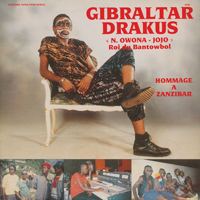
GIBRALTAR DRAKUS
HOMMAGE A ZANZIBAR (Awesome Tapes from Africa 48)
If you missed the Bikutsi wave the first time around (35 years ago), it is back and just as intense as ever. The name is a Beti word for "beat the earth," and is a relentless 6/8 rhythm played in speedy quarter notes on a guitar. In Cameroon, where it originated, it quickly eclipsed the makossa sound popularized by Manu Dibango as bands like Los Camaroes and Les Veterans took center stage. In the late 1980s Les Têtes Brulées swept the world with their crazy antics, shaved heads and body paint that was an update on traditional body scarification. I got to see them in a small club and was swept away by their energetic performance. But to me it was pop and had its day, so I have not gone back to hear it in almost 30 years now. Now these two reissues from Awesome Tapes from Africa go back to that moment when the music erupted globally. Zanzibar (Théodore Epeme) was Les Têtes Brulées' guitarist who created a great innovation that defined the sound: he stuck foam rubber under his guitar strings so they were muted and created a metallic sound mimicking the rural balafon. Drakus was the youngest member of that band and this album was his tribute to his mentor (Zanzibar died suddenly in 1987: we in the West assumed it was AIDS; the Cameroonian public thought his jealous bandmates had murdered him!).
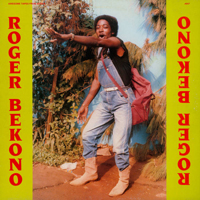
ROGER BEKONO (Awesome Tapes from Africa 47)
More bikusti music from Yaoundé, this time a solo artist named Roger who started out emulating the likes of Miriam Makeba and Michael Jackson. His breakthrough came when the Pope visited Cameroon and he was asked to compose the official song of welcome. Hits followed and this, his third album, scored big with the song "Jolie Poupée (Pretty Doll)," which is not, however about John Paul 2. In those days a lot of music came out on cassette and you could fit two albums easily on a C60 cassette, so if you feel like reliving the late 1980s, get yourself a cassette and put Drakus on one side and Bekono on the other. It all flows together nicely. There are live and also programmed drums to maintain the specific BPM rate guaranteed to fill any dancefloor.
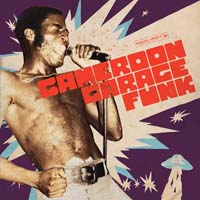
CAMEROON GARAGE FUNK
1964–79 (Analog Africa 32)
Samy ben Redjeb is a pioneer of the genre of African Funk with his reissues on Analog Africa, from Voodoo Funk from Benin to Edo Funk from Benin City to the new Garage Funk from Cameroun. Labeling a genre of music may codify it for a potential audience but it also circumscribes its appeal and ghettoizes it from expansion into other forms. It was probably Fela and his Koola Lobitos who defined the genre, then Strut, Vampisoul, Soundway and other labels milked it to death in the early 2000s. So African Funk has become a meaningless term for the most part, but is so potent in marketing that I notice African 45s on Ebay described as "Killer riff" or "Horn stepper" are stalled at the opening bid of $9.99 but one, described as "Afro funk," is over $200 with a day still to go [it sold for $846!]. This latest episode from the prolific Analog Africa label has a funky booklet also: typewritten text with blurry display type, crooked grainy photos — no straight lines anywhere! Yet all add to the atmosphere suggesting this is a coherent theme rather than just a collection of Cameroonian oldies. There are one or two familiar names here, Los Camaroes, Black Tulips, Golden Sounds, but one thing they all have in common is a close study of James Brown's Live at the Apollo double-album of 1963. While that is a unifying factor, not all of them rise to the effort: Johnny Black and Les Jokers are a hot mess; the Damas Swing Orchestra are also rather feeble. According to Robert Farris Thompson, the word funky derives from Kikongo "Lu-fuki" meaning strong body odor. It's used in praise to imply someone sweated really hard to achieve their aims, like James Brown throwing himself across the stage, screaming and doing the splits. Exertion exemplifies the positive energy of a hardworking person: "Funk in black American jazz parlance can mean earthiness, a return to fundamentals." (Flash of the Spirit, pp. 104–55). For the most part these songs were issued by Sonafric in Paris and no money changed hands. Musicians were presumed to be gratified to hear their songs on the radio and have a physical copy to give their mother. Sonafric was started by Perse and David, former Ngoma employees who acquired Fonior under contentious circumstances and also ran the Sonodisc label. There is some history here; I have also written about it here.
The groove on "Monde moderne" by Pierre Didy Tchakounte et les Tulipes Noires reminds me of "Ode to Billy Joe." Now before you say that is absurd, remember that musical influences come from all over, and especially from the random popular music played on the radio. Lots of black blues musicians in the 20s and 30s dug Jimmy Rodgers and Grand Ole Opry; in fact when Chris Strachwitz of Arhoolie was recording in the deep south in the 1960s, over and over again bands told him they loved Lawrence Welk! My favorite track on this collection is the standout "Quiero wapacha," a guaracha by Charles Lembe which appeared on an Ngoma EP, recorded in Paris, and was later included on Africa Boogaloo from Honest Jons. Lembe, a fine guitarist, has timbales, congas, bass and piano backing him: clean and sweet. Golden Sounds' "Ngamba" is more Afro-beat and the closer "Mezik me mama," by Mballa Bony (of Los Cameroes) has a plain-jane Velvet Underground simplicity to it: this must be the "garage" element. I have to disagree with Bony when he says the Camerounian musicians covered James Brown so well they surpassed the originals. I am sorry but these imitators and not a patch on the originator.
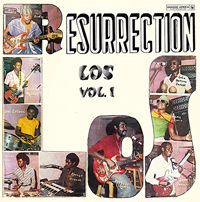
LOS CAMAROES
RESURRECTION LOS VOL 1 (Analog Africa)
This was the final album of a once massive Camerounian band who broke up in 1979. It was recorded live in the Mango Bar, Yaoundé and has laid-back vocals with a smoldering guitar. Lead guitar wizard Messi Martin has a catch-all approach to Makossa, Bikutsi and even Cavacha in the breakdowns and solos. The disc comes out on vinyl in a limited edition at the end of September. There's a big room sound to the drums and loads of Echoplex on the guitar as well as the vocal mikes. Oddly it reminds me of my beloved Super Mama Djombo from Guinée-Bissau more than other Camerounian bands. I even get a feel of Angola in there. Whatever it is, legendary is a fair epithet, and once again we owe Analog Africa bigtime for finding it. Analog's man-on-the-spot Samy Ben Redjeb explains how the music evolved. Bikutsi was traditionally played on balafon but Messi chewed up bits of paper and stuck them under his strings to deaden them and give his guitar a balafon sound. This drove the fans wild. Despite massive radio hits and local popularity, the band fell apart by the mid-70s: the solid grounded leader Jean Gabari could not longer contain the quixotic lead guitarist Messi. Then in 1979 a businessman asked them to reform for one more round. They opted for playing live in a club, rather than the studio and just picked up where they had left off, thriving off the energy of the crowd. It is shimmering and exciting music. There was no volume two, sadly, as Jean Gabari, the bandleader, was already ill, and was forced to retire. As usual none of the members ever reached these heights again, so we are fortunate to have this gem literally resurrected for us.
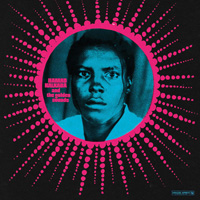
HAMAD KALKABA & THE GOLDEN SOUNDS
1974-5 (Analog Africa 24)
Analog Africa is one of the most prolific, diverse and provocative labels going. It focusses on reissues and has created a fabulous back catalogue of music we never even knew existed, from all over Africa. And Analog Africa strides ahead with yet another fantastic reissue, the second or third this year (depending whether you count disco). We are still digesting Los Camaroes' stellar album, which reappeared this summer, and here comes another previously unknown gem. This short album presents the complete works (3 singles or 6 sides) of Hamad Kalkaba backed by a band who I am pretty sure are not the same Golden Sounds of "Zangalewa" fame. The "continuing adventures of Samy" fill us in on the story of how label boss Ben Redjeb found a single by this artist and then went on a quest for more works by this one-time master of a particular Northern Camerounian rhythm known as the Gandjal. Finding the music was tough, but it was not hard to track down the artist, for, once identified, he was known to everyone as a retired colonel who had gone on to the nation's Olympic committee and thence to head the Confederation of African Athletes. As a soldier Kalkaba joined the band of the Republican guard and rose to be leader, learning the various instruments along the way. But at the time, 1970, they played European music and he wished their own rhythms could be showcased the way Makossa and Bikutsi were being performed in other parts of the former French colony. (Originally a German territory, Cameroun was divided between Britain and France after WW1, but when Independence loomed in 1960, the Northern British part opted to join Nigeria.) Like other African artists of the 70s the aim of young Camerounian musicians was to take traditional rhythms and modernize them with electric guitars, keyboards and drum kits. "Lamido," one of the harsher cuts on here, has an attack reminiscent of Fela, a grindingly funky groove, yelled vocals and an ominous organ hovering in the back with even more threatening horns punching through as the vocalist grunts "Bismillah!" I have no doubt these were massive hits in their day and shocked the people with their bold thrust away from the traditional thumb piano and rattles into electric big band sounds. They even turned some of these traditional songs into military marches. They did include a balafon and talking drum in the lineup but these recordings were made in a Protestant mission and consequently the mikes are not balanced, which is why there is a distant rumble from some of the less-audible instruments. "Gandjal kessoum" kicks right in with wild drums and wildly flailing sax in a hot take. The lyrics (which are included) are socially conscious and show how Kalakaba could have been a transformative force as a singer had he chosen to continue that career. But after his band appeared at Festac '77 as representatives of Cameroun he decided to devote himself to the more secure career of the military. This is short, sweet and mighty fine.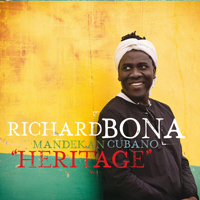
RICHARD BONA
HERITAGE (Membran)
Richard Bona hails from Cameroon and has now released an impressive 8 solo albums. He is a bassist and has collaborated with many African and American artists, including Lokua Kanza, Pat Metheny, Bobby McFerrin, and Mario Canoge, but has put together a new outfit for this album: Mandekan Cubano. He decided to explore the connection between Cuban music and its roots in the 15th-century Mandinka culture of West Africa. This seems overly ambitious but relax and enjoy the music. "Bilongo" has a familiar refrain --"Kikiribu Mandinga"-- and this song by Guillermo Rodríguez Fiffe has been covered by everyone, including a great version by Ismael Quintana with Eddie Palmieri. Bona performed it in Vienna 2012 with the same band under the title "Engingilaye." It's worth hearing again, in fact my friend Lulu sent me this version by Conjunto Casino featuring Alfredito Valdés. This must be a touchstone for the Afro-Cuban researcher looking for the Mandinka connection. Kikongo, Yoruba and Mandingo words and phrases survive in Cuban culture and often make it into songs. This is the stand-out track on the album, which is well-produced (by Quincy Jones) and continues Bona's approach of treating each album as a story with chapters. Other fine tunes, including "Santa Clara con montuno" and "Muntula moto," sound like covers, but as with "Bilongo," Bona takes the credit.
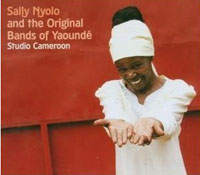
SALLY NYOLO & THE ORIGINAL BANDS OF YAOUNDÉ
STUDIO CAMEROON (TUGBOAT TUGPR1043)
We haven't heard anything sparklingly original from Sally Nyolo since her 1996 debut (She backed Toure Kunda and toured with Zap Mama in the 90s) and here she is doing something remarkable. She grew up in Paris but recently went home to Southern Cameroon and set up a studio in a tin-roofed building and held open court for any musicians that wanted to come along. So she got to discover what had been happening in her absence. Some of the acts just do their own thing, others collaborate with Nyolo so it's like a sampler of the rootsier side of Cameroon, far from European studios with their toys and tools. The result is carefree and quite magical. The most famous rhythm from Cameroun is Bikutsi, which is jagged African rock and roll. But in addition to guitars there are balafons and other more organic instruments on here such as the wooden drum called the nkule. It starts off sounding like Pere Ubu with a group called Guêyanka, followed by more traditional-sounding pieces.